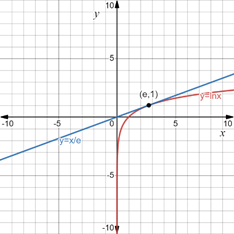
(a.)
An equation for this tangent line.
(a.)
Answer to Problem 71E
It has been determined that an equation for the given tangent line is
Explanation of Solution
Given:
The line through the origin tangent to the graph of
Concept used:
The equation of a line passing through the origin and having slope
Calculation:
It is given that the line through the origin tangent to the graph of
Then, this tangent line passes through the origin and has slope
So,
Put
This is the required equation.
Conclusion:
It has been determined that an equation for the given tangent line is
(b.)
An argument based on the graphs of
(b.)
Answer to Problem 71E
It has been explained why
Explanation of Solution
Given:
The line through the origin tangent to the graph of
Concept used:
The equation of a line passing through the origin and having slope
Calculation:
As determined previously, the equation of the tangent is
The graphs of

It can be seen that the graphs of
It should also be noted that the graph of
This implies that
This is the required proof.
Conclusion:
It has been explained why
(c.)
To Show:
(c.)
Answer to Problem 71E
It has been shown that
Explanation of Solution
Given:
The line through the origin tangent to the graph of
Concept used:
The equation of a line passing through the origin and having slope
Calculation:
As shown previously,
Since
Now,
Multiplying both sides of the above inequality by
Simplifying using property of logarithm,
This is the required proof.
Conclusion:
It has been shown that
(d.)
To Show:
(d.)
Answer to Problem 71E
It has been shown that
Explanation of Solution
Given:
The line through the origin tangent to the graph of
Concept used:
The equation of a line passing through the origin and having slope
Calculation:
As shown previously,
Since the exponential function,
Now,
This implies that
Simplifying,
This is the required proof.
Conclusion:
It has been shown that
(e.)
Which is bigger;
(e.)
Answer to Problem 71E
It has been determined that that
Explanation of Solution
Given:
The line through the origin tangent to the graph of
Concept used:
The equation of a line passing through the origin and having slope
Calculation:
As shown previously,
Put
This implies that
Conclusion:
It has been determined that that
Chapter 3 Solutions
Advanced Placement Calculus Graphical Numerical Algebraic Sixth Edition High School Binding Copyright 2020
- The correct answer is Ccould you show me how to do it by finding a0 and and akas well as setting up the piecewise function and integratingarrow_forwardT 1 7. Fill in the blanks to write the calculus problem that would result in the following integral (do not evaluate the interval). Draw a graph representing the problem. So π/2 2 2πxcosx dx Find the volume of the solid obtained when the region under the curve on the interval is rotated about the axis.arrow_forward38,189 5. Draw a detailed graph to and set up, but do not evaluate, an integral for the volume of the solid obtained by rotating the region bounded by the curve: y = cos²x_for_ |x| ≤ and the curve y y = about the line x = =플 2 80 F3 a FEB 9 2 7 0 MacBook Air 3 2 stv DGarrow_forward
- Find f(x) and g(x) such that h(x) = (fog)(x) and g(x) = 3 - 5x. h(x) = (3 –5x)3 – 7(3 −5x)2 + 3(3 −5x) – 1 - - - f(x) = ☐arrow_forwardx-4 Let f(x)=5x-1, h(x) = Find (fo h)(0). 3 (fo h)(0) = (Type an integer or a fraction.)arrow_forwardFill in the blanks to write the calculus problem that would result in the following integral (do not evaluate the interval). Draw a graph representing the problem. π/2 So/² 2xcosx dx Find the volume of the solid obtained when the region under the curve 38,189 on the interval is rotated about the axis.arrow_forward
- Let f(x) = -5x-1, g(x) = x² + 5, h(x) = · x+4 3 Find (hog of)(1). (hogof)(1)= (Simplify your answer. Type an integer or a decimal.)arrow_forwardFor the given function, find (a) the equation of the secant line through the points where x has the given values and (b) the equation of the tangent line when x has the first value. y= f(x) = x²+x; x=-1,x=2 a. Which of the following formulas can be used to find the slope of the secant line? ○ A. 2-(-1) f(2) f(-1) 2+(-1) C. 1(2)+(-1) The equation of the secant line is 1(2)+(-1) О в. 2+(-1) f(2)-(-1) D. 2-(-1)arrow_forwardplease do not use chat gptarrow_forward
 Calculus: Early TranscendentalsCalculusISBN:9781285741550Author:James StewartPublisher:Cengage Learning
Calculus: Early TranscendentalsCalculusISBN:9781285741550Author:James StewartPublisher:Cengage Learning Thomas' Calculus (14th Edition)CalculusISBN:9780134438986Author:Joel R. Hass, Christopher E. Heil, Maurice D. WeirPublisher:PEARSON
Thomas' Calculus (14th Edition)CalculusISBN:9780134438986Author:Joel R. Hass, Christopher E. Heil, Maurice D. WeirPublisher:PEARSON Calculus: Early Transcendentals (3rd Edition)CalculusISBN:9780134763644Author:William L. Briggs, Lyle Cochran, Bernard Gillett, Eric SchulzPublisher:PEARSON
Calculus: Early Transcendentals (3rd Edition)CalculusISBN:9780134763644Author:William L. Briggs, Lyle Cochran, Bernard Gillett, Eric SchulzPublisher:PEARSON Calculus: Early TranscendentalsCalculusISBN:9781319050740Author:Jon Rogawski, Colin Adams, Robert FranzosaPublisher:W. H. Freeman
Calculus: Early TranscendentalsCalculusISBN:9781319050740Author:Jon Rogawski, Colin Adams, Robert FranzosaPublisher:W. H. Freeman
 Calculus: Early Transcendental FunctionsCalculusISBN:9781337552516Author:Ron Larson, Bruce H. EdwardsPublisher:Cengage Learning
Calculus: Early Transcendental FunctionsCalculusISBN:9781337552516Author:Ron Larson, Bruce H. EdwardsPublisher:Cengage Learning





